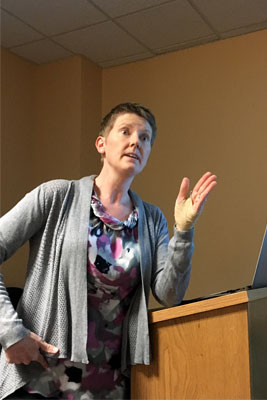Stroke is the number one cause of adult disability in the United States. The most common type of stroke is ischemic (non-bleeding), which occurs when there is sudden loss of blood flow to an area of the brain, causing loss of neurological functioning. Symptoms of ischemic stroke include, but are not limited to, sudden onset numbness or weakness of the face, arm, or leg, difficulty speaking or understanding speech, difficulty with walking or balance, confusion. The key is that the loss of normal function comes on suddenly. There are many risk factors for ischemic stroke, some out of our control, like race and age; and some that we can control, like blood pressure and smoking. Stroke is a time sensitive illness, meaning that when it occurs, it is important to seek immediate medical attention by calling 911.
 Older adults are at greater risk for ischemic stroke compared to younger adults, but they may not be receiving the same treatment as younger individuals. Current treatments for stroke include intravenous medication (tPA), which breaks down blood clots, and intra-arterial procedures (IA), which surgically extract the clot. The quicker either of these treatments is received the better the chances of recovery. How physicians determine which to administer is determined by a number of factors.
Older adults are at greater risk for ischemic stroke compared to younger adults, but they may not be receiving the same treatment as younger individuals. Current treatments for stroke include intravenous medication (tPA), which breaks down blood clots, and intra-arterial procedures (IA), which surgically extract the clot. The quicker either of these treatments is received the better the chances of recovery. How physicians determine which to administer is determined by a number of factors.
Karen Albright, DO, MPH, a Ph.D. student in the Department of Epidemiology, along with colleagues from the Divisions of Stroke and Geriatrics, examined ischemic stroke prevalence and treatment by age. She presented this research at the May 2 Discoveries in the Making at Hoover Public Library. Using data from the National Inpatient Sample, she found that while older adults (aged 65+) accounted for 68 percent of ischemic stroke discharges at hospitals across the U.S., they only make up approximately half of the stroke patients receiving acute treatment (tPA and IA). Not only is there a discrepancy in treatments received, but the Clinical Trials used to establish the efficacy of these treatments often exclude older individuals. So why aren’t older individuals receiving treatment?
The authors speculate that older individuals may arrive later or not meet criteria for safely administering acute stroke treatment, but concerns that ageism may play a role remain. Perhaps providers feel that some of these older Americans are too frail to safely tolerate acute treatment. Unfortunately, data from the National Inpatient Sample was not able to address this question, and thus reasons for these differences remain unknown.
Karen’s advice to everyone living in the stroke belt: focus on preventing stroke.
- Maintain a healthy lifestyle (eat plenty of fruits and vegetables, get regular exercise), make sure your blood pressure is under control, stop smoking, and take your medications as directed (even if you don’t think they are helping).
- Be prepared and make sure you know the symptoms of stroke. Call 911 immediately if you believe you or someone around you is having a stroke.
- Finally, it is important to specifically ask for treatment (tPA and IA). Ask your physician if you quality for tPA or IA. Physicians make informed decisions based on your current condition, your medical history, their perception of your wellness or frailty, et cetera but you have the right to play an active role in your care. Don’t be afraid to ask for treatment.
